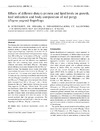Please use this identifier to cite or link to this item:
https://accedacris.ulpgc.es/jspui/handle/10553/723
| Title: | Effects of different dietary protein and lipid levels on growth, feed utilization and body composition of red porgy (Pagrus pagrus) fingerlings | Authors: | Lenoir Schuchardt,Dominique Vergara Martín, José Manuel Fernandez-Palacios, H. Kalinowski Herrera, Carmen Tatiana Hernandez-Cruz, C.M Izquierdo, Marisol Robaina, L. |
UNESCO Clasification: | 251092 Acuicultura marina | Keywords: | Bocinegro (Peces) Alimentación Cría y explotación Lípidos Proteínas, et al |
Issue Date: | 2008 | Journal: | Aquaculture Nutrition | Abstract: | Two feeding trials were conducted to determine the minimum dietary protein level producing maximum growth, and the optimum protein to energy ratio in diets for red porgy (Pagrus pagrus) fingerlings, respectively. In the first trial, six isoenergetic diets were formulated with protein levels ranging from 400 to 650 g kg-1 in increments of 50 g kg-1, and fed for 11 weeks to 2.8 g average initial weight fish. Weight gain, specific growth rate and feed efficiency were significantly higher with diets containing higher protein levels, when compared with dietary levels below 500 g kg-1. The highest protein efficiency ratios were obtained in fish fed 500 g kg -1 dietary protein. The minimum dietary protein level producing maximum fish growth was found to be 500 g kg-1. In the second trial, 15 g average initial weight fish were fed for 12 weeks, six diets containing three different lipid levels (100, 150 and 200 g kg-1) combined with two protein levels (450 and 500 g kg-1). Weight gain values increased when dietary lipids increased from 100 to 150 g kg-1, with a further decrease for 200 g kg-1 lipids in diets; the lowest fish growth being supported by 200 g kg-1 dietary lipids. Fish growth was significantly higher when dietary protein increased from 450 to 500 g kg -1. There was no evidence of a protein-sparing effect of dietary lipids. Liver protein and lipid contents were low when compared with other fish species. All diet assayed produced high liver glycogen accumulation. The recommended protein and lipid levels in diets for red porgy fingerlings were 500 and 150 g kg-1, respectively. | URI: | https://accedacris.ulpgc.es/handle/10553/723 | ISSN: | 1353-5773 | DOI: | 10.1111/j.1365-2095.2007.00484.x | Source: | Aquaculture Nutrition [ISSN 1353-5773], v. 14 (1), p. 1-9, (Febrero 2008) |
| Appears in Collections: | Artículos |
SCOPUSTM
Citations
60
checked on Jun 8, 2025
WEB OF SCIENCETM
Citations
55
checked on Jun 8, 2025
Page view(s)
132
checked on Oct 5, 2024
Download(s)
261
checked on Oct 5, 2024
Google ScholarTM
Check
Altmetric
Share
Export metadata
Items in accedaCRIS are protected by copyright, with all rights reserved, unless otherwise indicated.
